ece
Peloponnisos, Greece
Navarino Bay, a large natural anchorage, about 2 miles in
diameter with an opening at the Sothern end, surrounded by cliffs and mountains
up to 2,500m high. In the small village
of Pilos we met several people who had spent most of
their lives overseas but had "come home" to retire, 2 from Canada, 2 from Australia, very helpful too.

My
good friend Ric named his boat Navarino so it was interesting to learn some of
the history. This is where the battle of
Navarino took place, 20 October 1827. The 2 miles diameter bay, cliffs all
around, has its single entry at one end less than half a mile wide. Apparently
the Turko-Egyption fleet of 89 warships, 2450 guns, was anchored in a 3/4
circle around the bay just inside the entrance, in theory a trap where any
ships sailing in would be caught by fire from all sides before they could sail
out. An Englishman, Codrington sailed in with 26 ships, 1270 guns, bands
playing on the deck and anchored in the middle (no war was declared at the
time). One of the Turk ships fired a shot and the battle began, after 4 hours
of bloody and devastating battle Codrington emerged the victor.


Would be great
to dive, water is very clear but Greece has now forbidden the use of dive tanks
as too much in the way of antiques was being smuggled out from this and many
other sites. When we checked in they almost wanted to confiscate ours but
relented after some discussion.
After a day or two of RnR we headed South down the coast to
Methoni, on the Western most cape of the Peloponnisos, an important position on
the ancient Greek and Roman etc, trading route to the East. Hence significant
fortifications and still remaining the Venetian castle and old walled city area
over 1,000 years old built on the point which has a very narrow strip of land
connecting it to the mainland, ideal for defending.
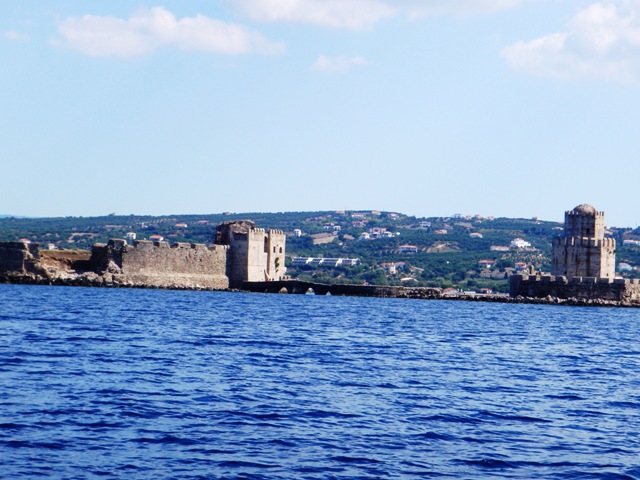
Nothing much of the old
city as the houses were wood but the walls, castle and a large marble column in
what was the town square still remain.
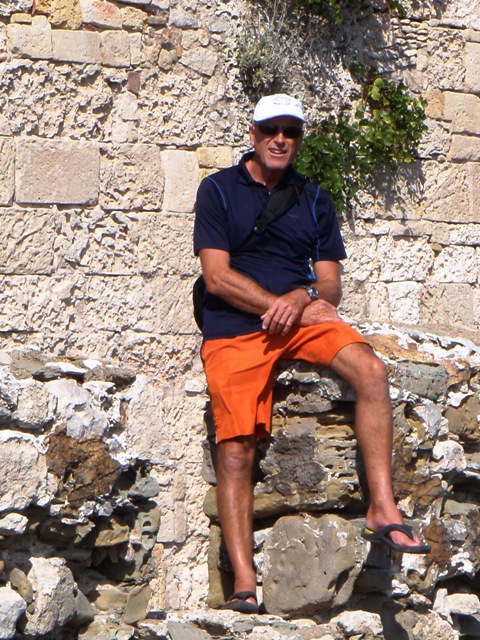
At night it is quite spectacular, all
lit by flood light on the ground bathing the walls in artificial light.
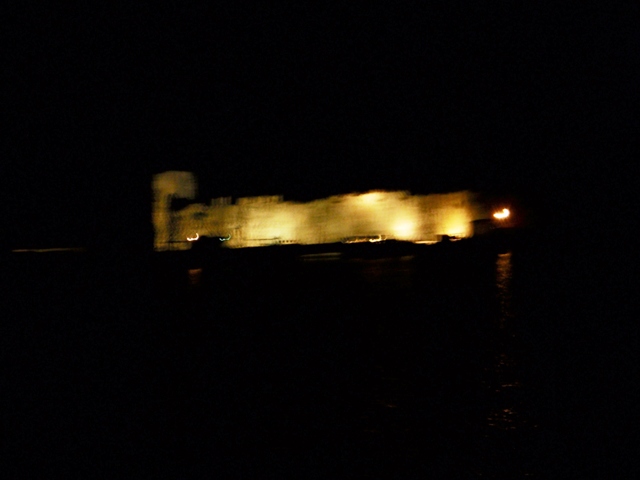
Another 30 miles, East, bought us to the day anchorage of
Dyros to see the renound Vlychade cave. What dramatic country, on the way to
this the middle of the 3 Peloponnisos capes we passed over depths, as shown on
our charts, approaching 2,000m, now we were looking up at baron mountains over
2,400m high! We had caught a couple of small mackerel one for the freezer, the
other Sasha baked beautifully for dinner which we had with red wine, straight
from the barrel (no preservative or crap) into plastic bottles, courtesy of
Antenello, from Sicily, what a life.

The Vlychade cave system is accessed at water level, each
guide propels a small flat bottom boat with up to 10 people for 1,300 meter
through very narrow tunnels. Although the guide has a paddle he mostly propels
the boat by pushing off the cave roof or walls while negotiating some very
tight turns. After the boat ride there was a 500m walk through more tunnels
just above the waterline to the exit. Luckily we were given hard hats to wear
as the cave roof, in many places was quite low.
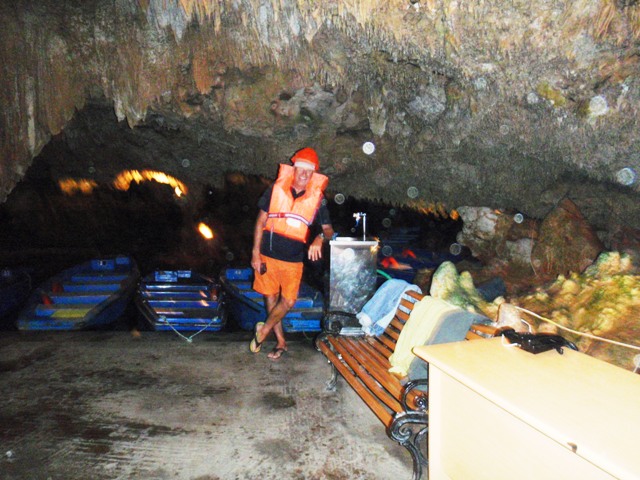

The cave system is literally a
mass of stalactites and stalagmites. As the water level has changed over the millenniums
many of the structures disappear into the depths. I think Sasha enjoyed the
actual caves more than I, for me, like so many other things we have done and
seen, the enjoyment was more in the journey rather than what was in the caves
themselves.
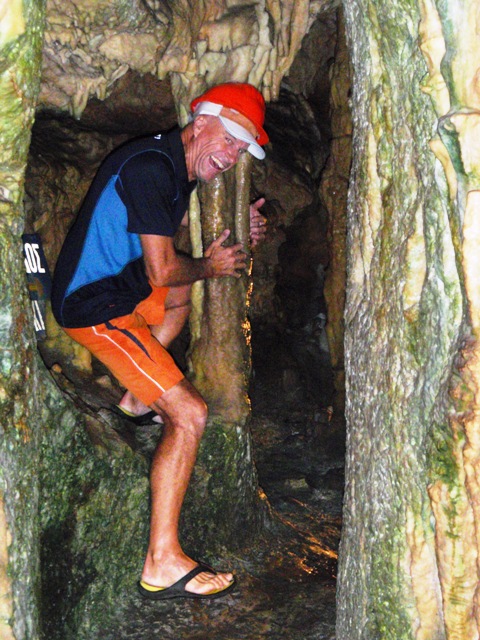
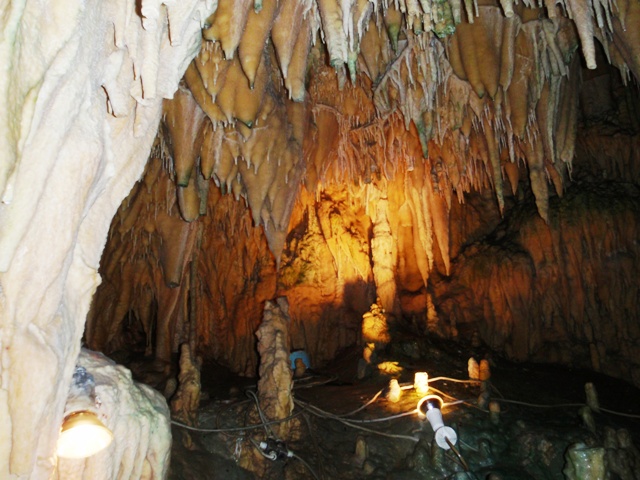
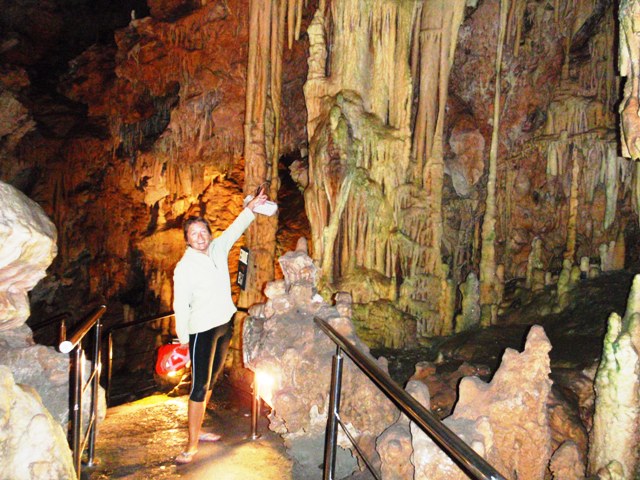
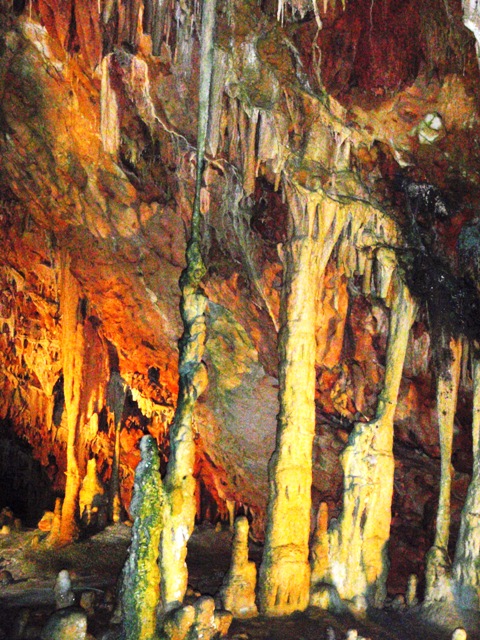
We left immediately after the cave visit for Porto Kayio,
around the second of the three Peloponnisos Capes
and up a couple of miles to the very protected bay. A Northerly blow of 25kts
or so was forecast and we anchored at the Southern end of the bay, at the tiny
village , on a lee shore. Not the best option but the small inlet on the
Northern side had very limited anchoring options. We like to swim so over the
side to be confronted with the most polluted water we had seen yet in the Med.
Plastic bags, plastic remnants and general rubbish everywhere. In parts so bad
that you couldn't see more than a metre or two.

Very soon back on board a
pitching Ednbal with the wind rapidly picking up soon well over 30kns. After
two days sitting it out on board we decided to get to shore. Far too rough to
get the outboard off Ednbal onto the dingy so another method had to be devised. Easy to get to shore, the wind
would take care of that, but getting back out against the wind, no chance
rowing. I joined a couple of long ropes together enough to let out the dingy
all the way to shore and easy to pull us back to Ednbal. Good plan. We let go
from Ednbal and drifted in to the shore but the rope wasn't quite long enough
so I also joined another spare in the dingy and grabbed the other end, or so I
thought. It turned out to be our dingy aft tie line that I had in my hand and
the line to Ednbal had disappeared over the side. Oh bugger! I looked around in
the shallows but couldn't find it so only one thing to do, swim out to Ednbal
where the other end was tied and follow the rope back into the shore. No
bathers of course so strip down to jocks and off I go, retrieved the rope and
finally tied up the dingy safe on shore ready for our return trip. Oh, getting
dry and dressed again, don't ask! We went for a short walk but with wind howling
and seeing Ednbal pitching so much we were too concerned to go too far. As we
walked past one of the two small water front cafe restaurants we were invited
in, we think, keep in mind we don't speak Greek. Seems the owner had been
watching us on the pitching yacht for two days and took pity on us. We ordered
two beers, the owner said, with a smile and very good English, one is on Maria.

Next morning things had calmed down enough to get shore and leave Ednbal in
reasonable safety. We had seen several camper van style vehicles with some sort
of storage boxes or cages on the back. While a little strange we didn't think
much of it but on our few mile walk in the mountains this day all would be
revealed. We had seen some big buildings in the hills on the other side of the
bay and decided to walk over to take a look. Unfortunately there was little in
the way of walk paths so we had to take the road that was luckily almost devoid
of traffic. On one of the side roads we came across one of the campers parked
on the side of the road.
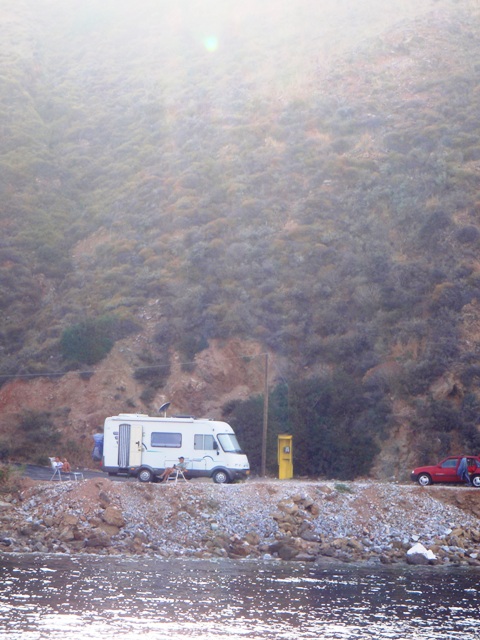
Two guys were dressed in camouflage and said hello.
One, a former ship captain spoke very good English so we had a chat. The cage
on the back was home to two dogs, the guys were camping out waiting for
migrating Quails. Apparently this was a very popular area for Quail hunting and
while few had been sighted so far this season we were told that last year they
shot 80 in one night, early morning. Lunch with obligatory GnTs was had sitting
on a bench with the full view of the bay spread out below us.
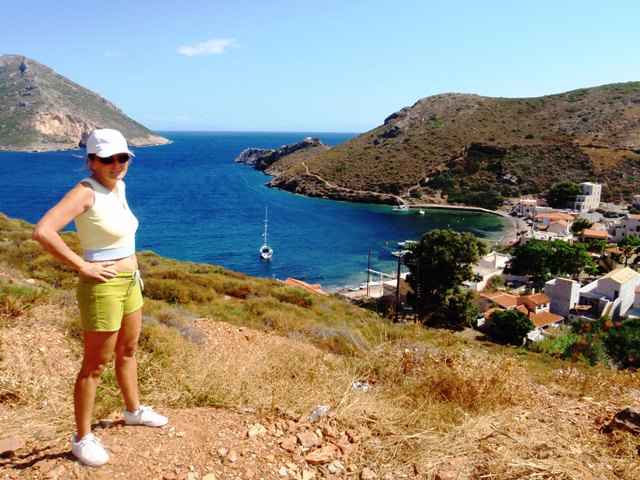
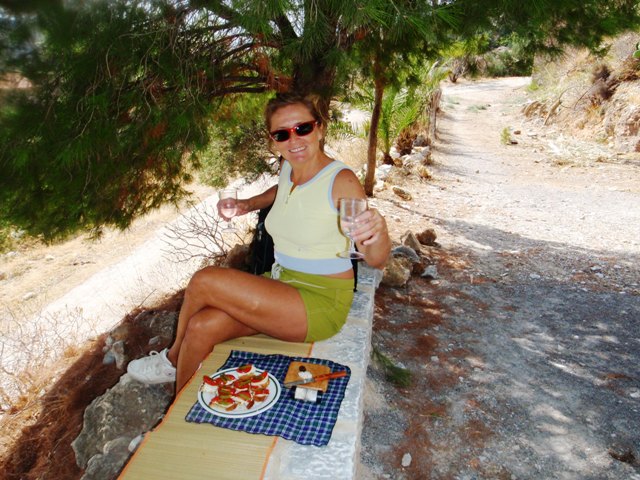
After three days the weather settled and backed to the west
to give us push to the island of Elephonesos on the Southern tip of the third
of the Peloponnisos Capes. What a beautiful clear, clean anchorage out from a
white sand beach over a km long we anchored in 3m of water and went for a long
swim, what a difference. Ashore was a large camping ground and cabins but now,
towards the end of the summer season it was virtually abandoned. For exercise
and some fresh fruit and veg we walked the 6km to the village on the mainland
side of the island. Very traditional Greek with many small hotels along the
water front to cater for summer holiday makers. We even found a little butcher
shop, not too well stocked however. Later we were walking on the beach when
ahead of us a lady had stepped on something in the water, it looked like a sea
urchin, purple around the puncture mark. She was in some pain so we went back
to Ednbal and Dr Sasha retrieved the appropriate treatments, as specified in
our first aid book, from our first aid kit. After treatment the pain quickly
subsided, she was most grateful! At night we normally lock our dingy alongside
Ednbal and put it out on the painter in the morning. Next morning we found
something quite unexpected, 100 or so small fish in the bottom of the dingy,
Hamsi, a little bigger than whitebait but prepared in Greece in a similar
fashion, essentially deep fried.
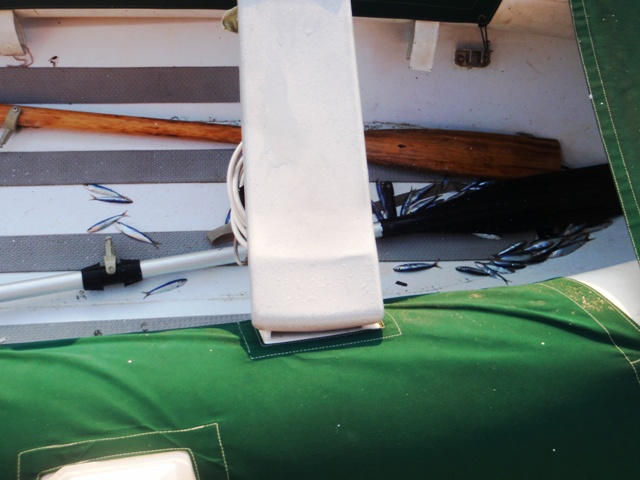
I was a little uneasy about eating the as we
didn't know when they had jumped into the dingy but Sasha was confident so we
had for dinner, fantastic they were.
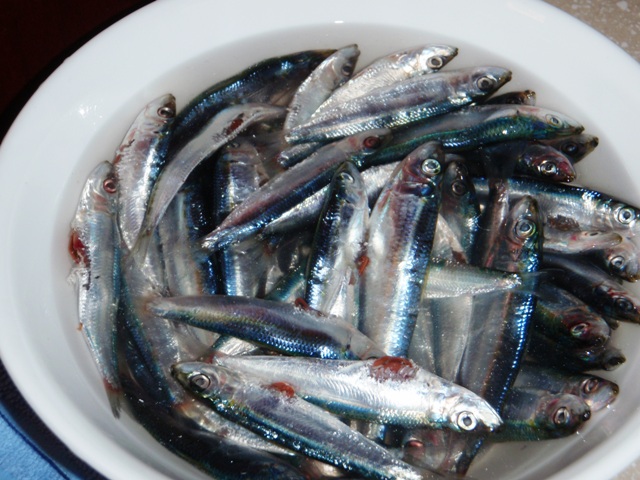
Milos
From Elephonesos we headed to Milos, no wind and had to
motor most of the 60 miles before anchoring in the very protected Milos bay off
the town of Adhamas.
Ashore we walked the village for fresh foods, much of which was available
direct from the grower's small trucks parked along the promenade. After picking
up jerry cans of fuel, the next day we headed for the main attraction -
Sarakiniko beach, spectacular waters edge caves and unique white granite rocks
on the Northern side.

With Ednbal anchored in deep water we took Tadpole ashore
to the rocks and tied her on a long line to enable the light offshore breeze to
keep her off the rocks. The white granite was quite unreal but the swim through
caves, while nice were devoid of plant life with little in the way of fish.
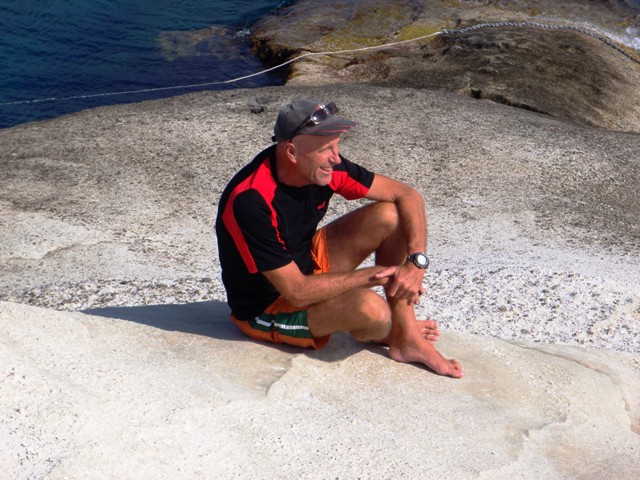
This was no overnight anchorage so we headed further East for some bays that
looked suitable for overnight. There was not a great deal of detail on our
electronic charts as I headed Ednbal in between a small rock island and Milos.
Suddenly the bottom came up from 6m to 2.5, mild panic ensued as the chart
indicated 6m minimum for our GPS position. Only option, backtrack the same way
we came in. After getting back into deep water and regaining composure we
anchored in a bay we had just sailed past and went ashore for a walk. Just over
the first small sand due we came across a guy bogged in the lightly grass
covered sand. The car was down to the axles so he wasn't going far. A few
minutes later another guy turned up who had spent time in Australia so could
talk to us. After putting some short wood planks under the wheels and
considerable pushing and shoving we managed to get the car mobile again. We
were offered a lift to where ever we wanted and we had trouble convincing that
we were just going for a walk. We had a very pleasant stroll, past small
farmlets with goats and sheep and a few fisherman's houses right on the water
line, can't be much swell or tide here!
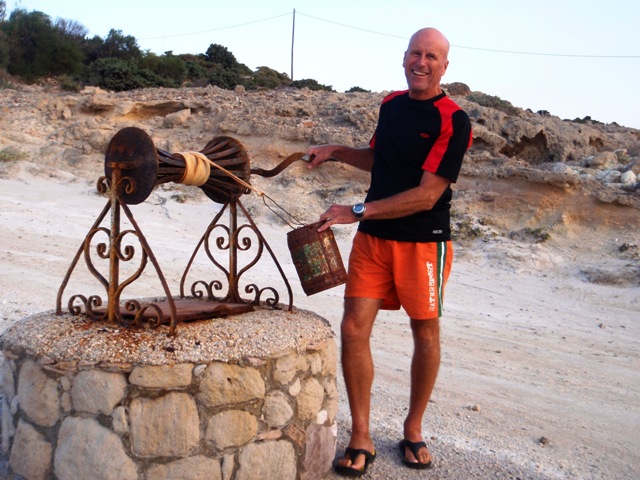
In the morning, taking a wide berth to the seaward side of
the rock island, we sailed into the small well protected bay just to the East
of Apollonia to take a look at that picturesque town. The village was a mixture
of old traditional fishing family homes and new age tourist B&Bs and hotels.
The beach on the Southern side, while nothing special, apparently attracts
swarms of tourists, especially German, during the summer season. We met the
owner of a house right on the water where we left the dingy tied up to a rock.
He had purchased one of the locally made vessels and sailed it to Germany and
back, via the Med then European rivers
and canals.

Our pilot guide did not recommend the bay for overnight so in early
afternoon we sailed up the Western side of Nisos Kimolos to the tiny bay and town
of Psathi. The bay was so small that we couldn't right in and had to anchor at
the mouth, very close to the inter island ferry terminal where it was quite
rough and surgey, so much so that we didn't even try and put the dingy in the
water. Not much sleep that night, between being rocked about by the sea and the
coming and going of ferries.
Ios
Next morning the wind had turned, more from the West to give
us a lovely day sail to the island of Ios. After anchoring in a quiet corner of
Iou bay we went over to the fishing boat harbour close to the town center.
There was no dingy dock but one of the friendly fishermen let us tie up next to
his boat. The Hora (common Greek term for the old village usually situated on a
high protected part of an island) was a short walk up very steep paths and
steps. Ios is a very popular spot in the height of the season but now in late
September many of those catering for the tourist market were already closed. It
was common to see signs up thanking people for their patronage and inviting
their return next season!
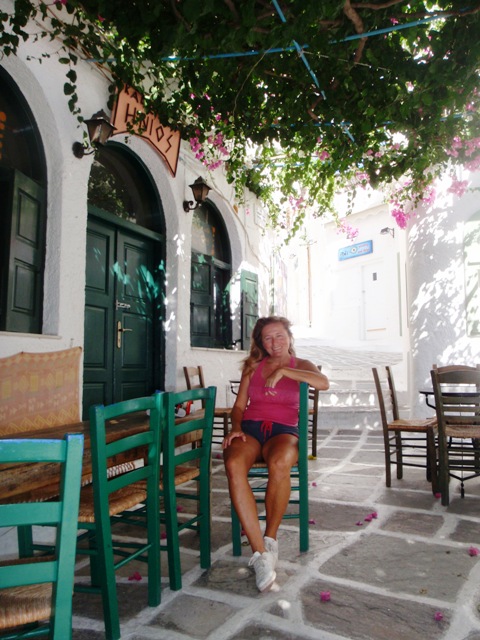
In the highest parts of the Hora were many windmills,
some restored, some in the process of being restored and still others about
ready to collapse. I managed to climb into one that was crumbling to find that
the big gears that drove the mill from the main shaft, driven by the wind, were
all made from wood!
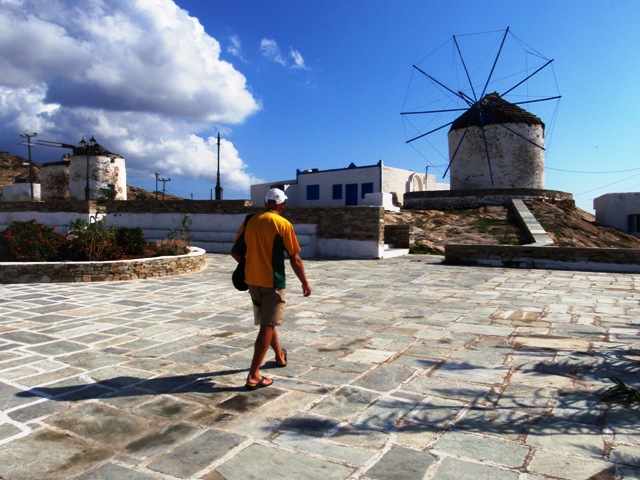

We walked to a number of places that provided spectacular
views of the town, bay and surrounding mountains.
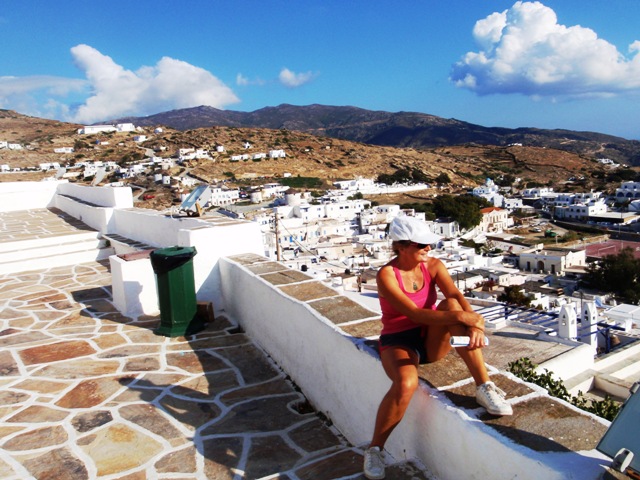
We moved from the main Iou
bay to the next one Kolitzani, and then a day after we sailed to the Southern
end of the island to anchor in the lovely clear waters of Manganari bay. Being the end of the season it
was virtually deserted. Hotel and bar owners were taking down and storing away
the hundreds of deck chairs, huge umbrellas and awnings normally covering
almost every square inch of the extensive yellow sand beaches. Not much
happening here but nice for walking the beach and rocks.
Amorgos
Next stop, the island
of Amorgos. Enroute, some
more exposure to the vagaries of Mediterranean sailing. We started off on a
lovely beam reach in 15kns of wind but less than an hour later it died out to
nothing so on came the engine. After half an hour up came the wind, 20kns right
on the nose, it took a couple of tacks, with shortened sail to get to the
corner of Amorgos where we could bear away a little and sail into the bay of
Katapola. We had intended to stop at a popular dive spot on the way in the
Kalotarissa bay, but the sea was just too rough. Katapola bay is quite deep and
narrow surrounded by mountains so as soon as we entered the wind died again and
we motored the last half mile to the wonderfully protected anchorage. Being
deep we had to anchor close to the shore with just one other yacht although 3
others came in later including a New Zealand yacht, Tangerine Green. Sasha had
done her homework on the "must see" spots and we had heard that
locally made bulk wine may be available. Our first walk through the old fishing
village turned up just one place with local wine but it was a restaurant/bar on
the tourist strip and they wanted some exuberant price, forget that. One thing
that stood out was the number of Deep Blue bars and restaurants for it was here
that the famous movie was filmed. One of them even showed the film on a
continuous basis and had "special guests", some of the extras who
were kids at the time, oh the price of fame.
The highlight must see was the Hora, on the mountain in the
middle of the island and the cliff face built monastery on the other side, a
lovely 10km walk. We set off early morning, opting for the "well
marked" walking trail rather than following the road. Alas it was not long
before we found we were not on the well marked trail but goat tracks through
the low scrub along the side of the mountain.
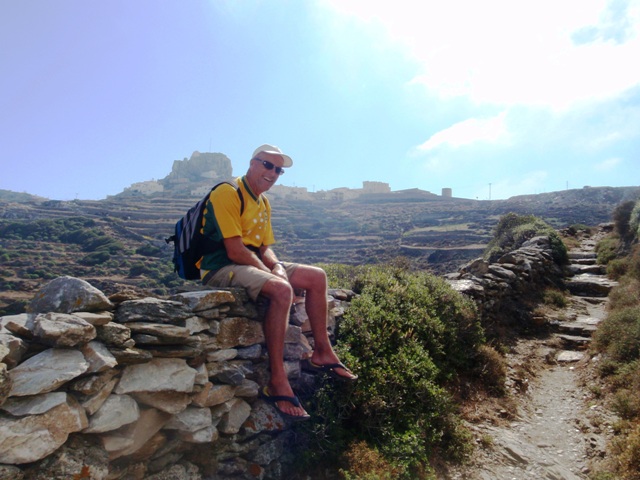
Eventually we did manage to
stumble across the well marked trail and made it the Hora, about half way to
the monastery, in a little over an hour. The Hora, situated on a wonderfully
defensive mountain top was second most spectacular only to Erica in Sicily.

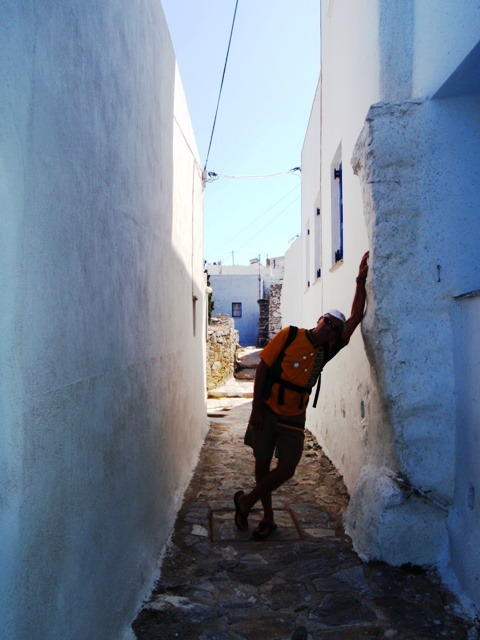

But, we were on a mission so straight through the Hora and on, down the other
side, at least initially, to the famous cliff side built monastery Panayia. A
long zig-zag path down before another ascent towards the monastery. Then, first
glimpses, almost unbelievable, how could people, all those centuries ago, build
something on a sheer cliff face. Very hard to photograph and give any sort of
perspective, you really can only see it for yourself to appreciate.
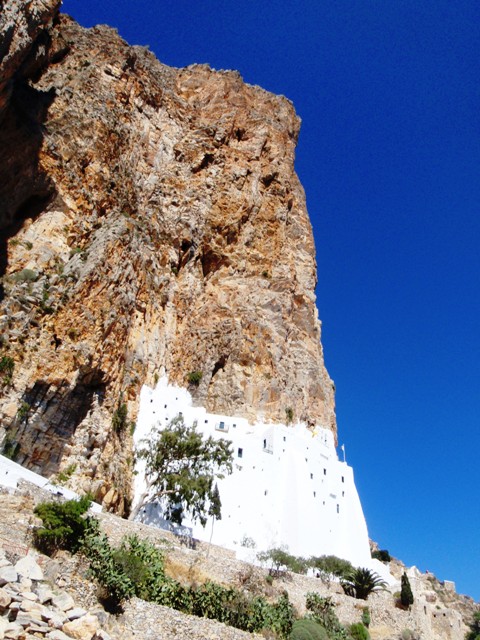
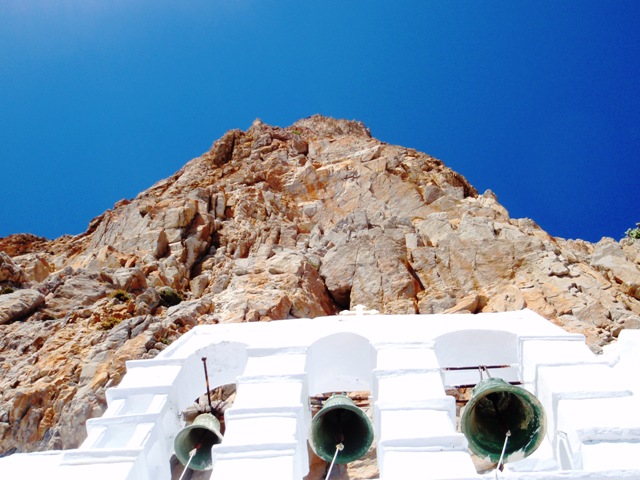
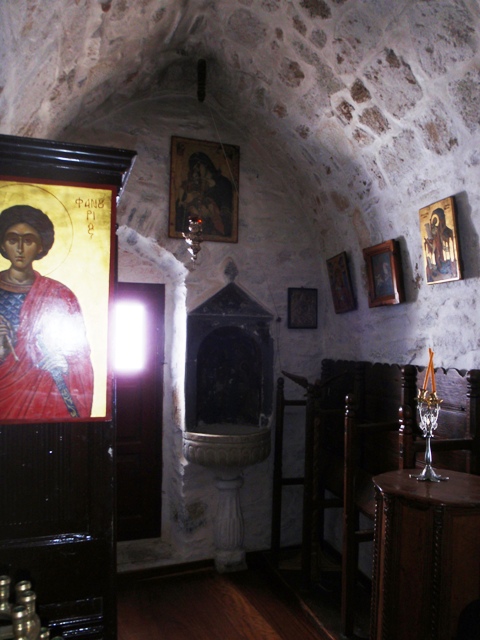
Only in
recent time have women been permitted to enter, then only with legs fully
covered, not just with pants but full length skirt. In case she forgot to bring
one, there were a number provided specifically for the purpose free of charge.
Entry, look around and complimentary aniseed liqueur drink with sweets provide
for a donation to the few monks that still inhabit. By early afternoon we were
back in the Hora and very much ready for a beer so we surveyed the area for a
suitable establishment and found a spot outside under some wonderful old trees.
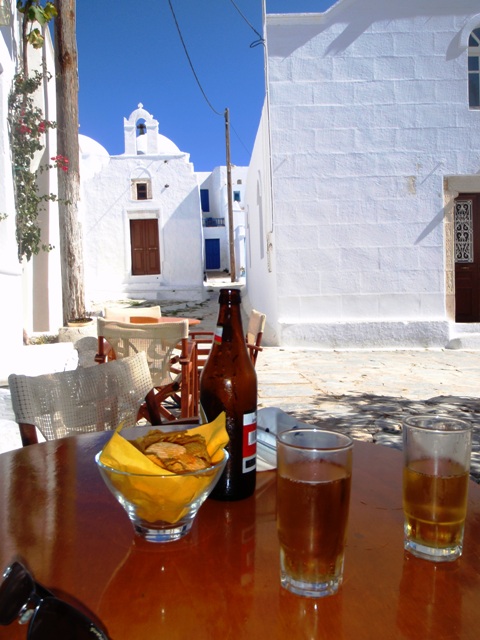
As with so many place in this part of the world we came across some who spoke
great English and loved Australia.
Sitting outside virtually by ourselves, we were treated to Men at Works
greatest hits with our ice cold beer. As we have said so many time, "it
doesn't get much better than this"! An uneventful stroll down the well
marked trail had us back to the outskirts of the fishing village by late
afternoon. The day wasn't over yet. Walking along the road, at the end of the
well marked trail, we passes a small property of grape vines with a narrow road
leading to a house. To Sasha's dismay I walked to the house to seek out the
owner for some of the local vintage. Unfortunately the older owner did not
speak English but his son, around 30, did. He introduced himself as Jim and
befriended us on the spot. No "vintage" was in stock, last years all
gone, this years still fermenting, bugger! Jim insisted on giving us a small
bottle of liqueur even though we told him we had bought one in the Hora. Back
on the boat we were treated to lovely late afternoon sun and decided to go
ashore for sunset where we met Jim again and invited him to Ednbal for a drink.
Jim was a teacher, having moved back to Amorgos from Athens. He gave us a brief
run down on the recent history of the island, no power before 1989, no cars
before 1993. His father still uses donkeys to get to his remote olive groves.
Leros
What a great island, but time to get going, a big
rendezvous, to meet up with friends from Perth, Ric and Pam, on the island of
Leros. Leros was a little out of our way
but we certainly did not want to miss the chance of spending some time with Ric
and Pam who were on their way to check out a yacht, Beneteau 411, that they
looking at buying into as a 1/3 share. In good Med fashion the wind came up,
died off, changed direction and came up again, at least we were able to put the
gennaker up for a while and hum along at 6kts. We were not sure where their
boat, Matilda 5, was but decided to head for the more protected anchorage in
the bay of Partheni at the Northern end of the island. Via the VHF radio we
found that they were in a marina almost at the other end of the island but would
be soon coming up to Partheni bay where the boat would be hauled out for winter
storage. Next day we caught the bus to Lakki and eventually found Matilda 5
with Ric and Pam close by. The syndicate arrangement had contracted a marina
berth, part of the time in the water, part on hard standing for a whole year so
this had been the base port for Matilda 5 for the year. Right now she was being
prepared for winter, commonly known as winterising. Tomorrow she would be moved
to Partheni bay for haul out.
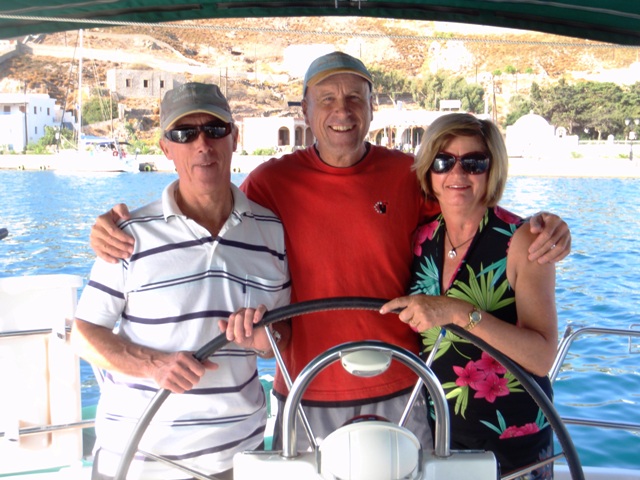
Next morning Ric and Agu (the syndicate member who had the last allocated period of use) arrived bright and early in Partheni bay ready for haul out. Once they had Matila in the lifting pool and she was lifted onto the hard they continued her winterising preparations. Meantime we decided to take a walk/hike over the rocky hills of the island following goat tracks. It was a case of gettto a peak, roughly guessing the direction and making it to the next. There were no houses, no people , no paths save the goats and their tracks through the rocks and spiny undergrowth. In the distance we could see a communications tower that, according to our map, had a road to it, an easy way to return. Around the tower we made it to the road to find that we seemed to be in some sort of restricted area; signs indicating no photography, military area etc. The road took a very windy decent down the steep hill so at one of the hairpin bends we decided to take a short cut to what looked like the main road back to Partheni bay. Stumbling over old, very rusty, barbed wire, likely a legacy of the second world war, we headed for a couple of large buildings at the base of hill. As we got closed a couple of people began to walk towards us, they had weapons, those things that shoot bullets! Turns our we are on an army base. The guys escorted us to the main gate, gave us a little bottle of lovely cold water and bid us goodbye. No real problem after all.
Ric and Pam joined us aboard Ednbal for sail and overnight stay on Patmos Island. Being power boaters they were keen to get a few tips on cruising sailing as well as a look at the islands old monastery and of course a few quiet beverages. All went well and the next day after a short stop-over to Lipso we returned to Alindas bay on Leros, not far from where Ric and Pam were staying in a hotel. We sometimes forget that people who are still working have the money for such luxuries! For a better look around Leros we hired scooters, well we hired a scooter, Ric and Pam a quad bike, for a day - good fun. Unfortunately it was at the end of the recognised tourist season so many "attractions" such as the castle, apparently galiantly defended during WW2, were already closed for the season. All in all we had a great week with very close friends from Perth.
Time for us to start seriously heading for our winter destination, Marmaris, Turkey, but not before stopping over in the GreekIsland of Rhodes. En-route to Rhodes we has a gear failure. Our mainsail tore completely across one corner, at the clue, from the foot right to the leech. We now could sail only on headsail. As with most other city ports, Rhodes has a couple of marinas, not for us, we headed for the reasonably protected anchorage, with just one other yacht in it, next door. Ashore we spent a day exploring the old walled city that had been home to various conquerors over the centuries, notably the crusading knights. Streets varied from just enough for 2 cars to pass down to almost corrides just wide enough to walk through. Of course, being a major tourist spot, cruise ship port, all manner of stuff was being hawked, along with a married of restaurants and bars. To see inside any building of note there was a fee, we paid for the privilege of walking along the top of the city wall, gives some insight to the amount of construction work to build the fortifications, moats and all. One evening we chatted to a French lady from the boatyard where were leaving our dingy tied up. She gave us a few tips on Turkey, notably stock up, things, especially booze, were much more expensive in Turkey. We walked to the local bulk supermarket, stocked up and caught a taxi back. The taxi driver seemed to love Aussies and took us to a small wharf not far from our dingy so that we could easily get all the food and booze into it without carring it through the boat yard. A real helpful, friendly guy. Getting on towards the end of October we pulled the anchor to head to Marmaris, 20 or so miles away. Well I should say tried to pull the anchor. Another yacht had come in the day before and anchored very close, too close, to us. Their engine had died and they were towed in so I didn't kick up too much fuss but now it looked like we had anchors mixed up. Only one answer, over the side, with a tank, in 7 metres of murky water. Turned out it wasn't another anchor but a huge bolder that our chain was caught under. It took some time and a lot of effort to finally free us. An hour or so later we were on our way to our "wintering" destination, Marmaris Turkey.

